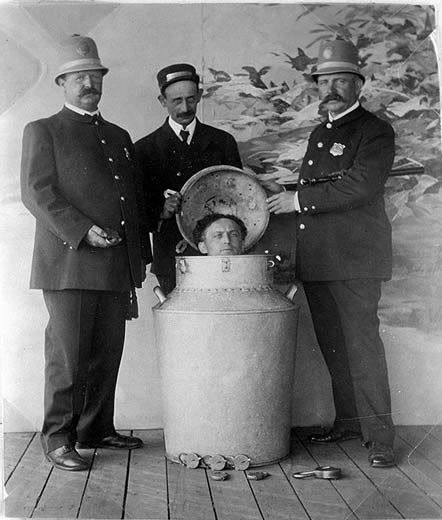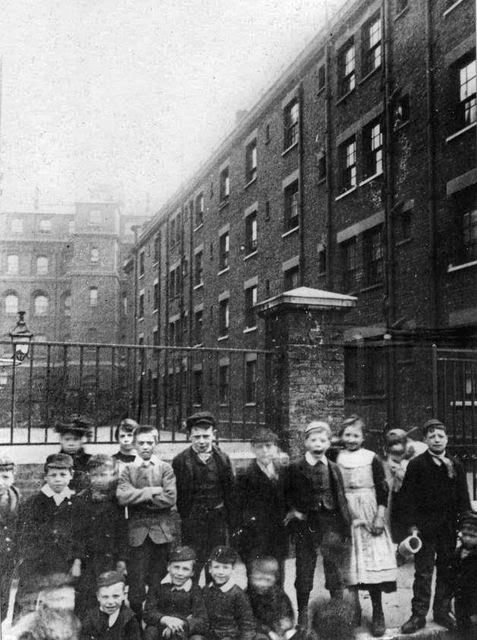The following is an excerpt from Troy Taylor's Spring 2002 book entitled "Into the Shadows" and is a portion from a lengthy section about the mysteries surrounding the life and death of famous magician Harry Houdini.
Houdini was well-known in the 1920's for his debunking of fraudulent Spiritualist mediums and for his natural explanations for much of the alleged evidence that purported to be paranormal. On at least one occasion though, Houdini found that he didn't have all of the answers!
Despite the private "death" pact that Houdini had made with his friends, he continued to debunk the mediums in his stage shows and through articles and books, showing how so-called "spirit forms" like "ectoplasm" could easily be created by the clever stage magician. But not all of the things that he witnessed during his psychic investigations was he so sure could be debunked. He kept vast files and records of his investigations and when he died, these reports came into the possession of Joseph Dunninger, Houdini’s friend and fellow conjurer.
In the wealth of material, there was a record of one case that baffled Houdini. His handwritten record of it was contained in the files, dated in Los Angeles on April 11, 1923. He was approached in reference to photographs that were to be taken of Mrs. Mary Fairfield McVickers who, before she died, requested that photographs be taken of her body at 5:00 on the afternoon of her funeral. According to reports, she claimed that she would appear in spirit form at that time. Mrs. McVickers made this unusual pronouncement on the occasion of her 73rd birthday in July 1922. She told her friends at the First Spiritualist Temple of Los Angeles, where she was a member, that she had experienced a vision of her approaching death. "I feel that if a picture is taken over my body about 5:00 pm on the day of my funeral", she told those present at the gathering, "I will be able to appear in spirit form."
Mrs. McVickers died the following April and a friend of the woman, Albert H. Hetzel, contacted Houdini and told him about the request the woman had made for a photograph to be taken of her body. Houdini was intrigued and so he got in touch with a friend and movie producer named Larry Semon about borrowing a camera man.
On the afternoon of the funeral, Nathan B. Moss, who worked for Keystone Press Illustration Service in Hollywood arrived with his camera and plateholders loaded with 14 negatives. Houdini had not told the man what they would be photographing and he and Moss went to a place called Howland and Dewey, Kodak representatives in Los Angeles. Houdini wrote that Moss "had no idea what I wanted but was under the impression that I was going to do a stunt and wanted a stunt picture. I told him that I wanted him to reload his plateholder with brand new plates which I would buy. He, not knowing the importance of the test, derided the fact of my not wanting to use his plates, but I told him that I might have to take an oath that I bought the plates and that therefore it was important."
When they arrived at the camera store, they asked for a dozen 5 x 7 plates and the clerk, Frank Hale, pulled out four packages of 12 each. Mat Korn, a customer in the store and a stranger to Houdini, was standing nearby and he was asked to choose one of the packets. He handed it to the magician, but Houdini noticed that one end of the package was not tightly sealed. He asked for five more packages and he asked another customer, identified as a Mr. Wheeler (a photographer for the Los Angeles Record newspaper), to choose a perfect one for him. Houdini purchased the package of plates and he and Moss entered the darkroom on the premises and removed the plates that Moss had already placed in the camera. He replaced them with the brand new plates, then placed all of the loaded plates into his camera. A few moments later, they left for the church so that they could arrive just before 5:00.
At the church, the body of Mrs. McVickers had been placed in a white, open casket, surrounded by flowers, located at the right of the pulpit. Moss then took 10 photographs of the scene and each of them was taken under the same time exposure of three minutes. In addition to Houdini and Moss, the witnesses included Albert Hetzel, J.M. Hall, Virgil Vlasek and Stanley Bruce of the Los Angeles Examiner.
After the photos were taken, the men left and went immediately to the Keystone Press Illustration office. The plates were immediately developed in Houdini’s presence and on one of the plates, they noticed a peculiar streak. Houdini wrote that "Mr. Moss made a print from this plate which caused a great deal of talk. Not one photographer could explain how this could be tricked. Mr. Moss offered a hundred dollars to anyone who could produce it under the same conditions, whereas no one could duplicate it." Houdini thought enough of this incident to make a note of it in his personal diary as well. "Took pictures at church," he penned. "A peculiar test."
Looking closely at the streak, it has an interesting formation, starting as a sharply-defined, broad band and then shifting to make two parallel lines. Just before it turned into a glowing mass, a third line starts to appear. A number of photographic experts studied the plate but stated that because of the nature of the image, it would have been practically impossible for it to have been caused by a defective plate, plateholder or camera.
Needless to say, a hoax was out of the question for it would have certainly not helped Houdini’s campaign against fraudulent Spiritualists for him to admit that a "ghost photograph" had been achieved in the church. Even so, he did have the integrity to admit that no satisfactory explanation could be found for the photograph. Joseph Dunninger wrote that Houdini made no attempt to debunk or explain the photograph. "He did not see the light. It made itself only evident on the photograph," said Dunninger. "This report shows that Houdini was willing to believe if the proof was brought before him... and was willing to give credit whenever credit was due."






No comments:
Post a Comment